The AMD Trinity Review (A10-4600M): A New Hope
by Jarred Walton on May 15, 2012 12:00 AM ESTAMD Trinity Gaming Performance
After the 3DMark results, you might be wondering if Intel has finally caught up to AMD in terms of integrated graphics performance. The answer is…yes and no. Depending on the game, there are times where a fast Ivy Bridge CPU with HD 4000 will actually beat out Trinity; there are also times where Intel’s IGP really struggles to keep pace. The good news is that at least everyone is now onboard the DX11 bandwagon, and compatibility with games has improved yet again for Intel. Here are our “Value” benchmark results for seven recent games; we’ll have more information in a moment.

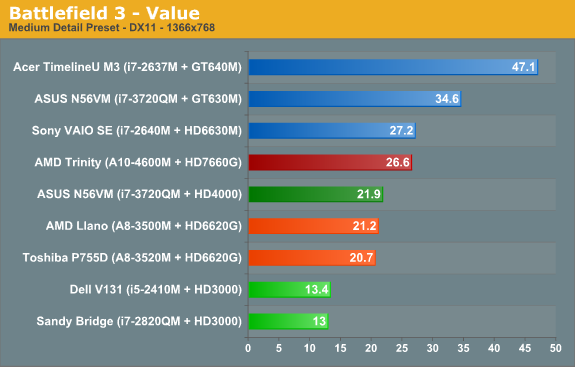
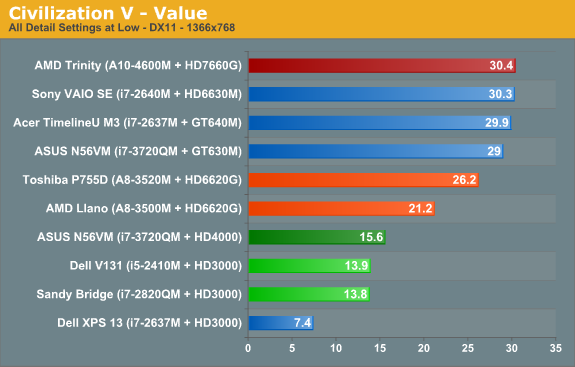

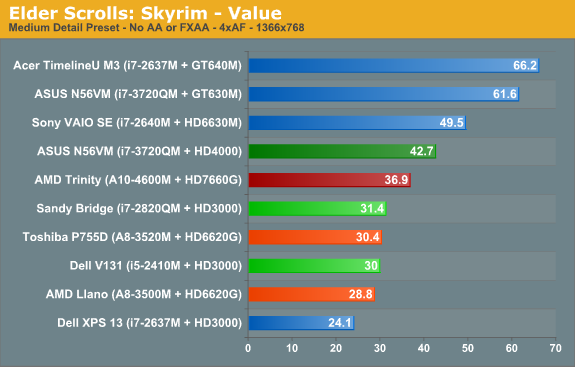
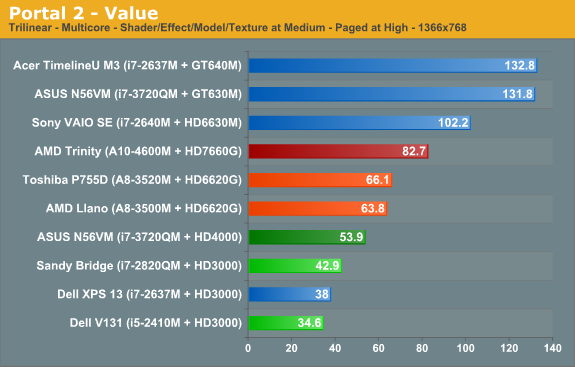
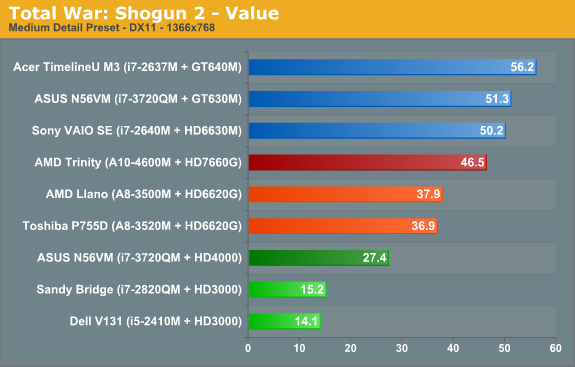
Out of our seven test titles, AMD’s Trinity leads any other IGP in four titles by a large margin. The other three titles actually have Ivy Bridge slightly ahead of Trinity, but the gaps aren’t nearly as big. Overall, the average performance across the seven games at our Value (medium) settings has AMD’s Trinity A10-4600M leading Intel’s i7-3720QM by 21%, and if we look at quad-core Sandy Bridge with HD 3000 (i7-2820QM) Trinity is 72% faster. Trinity is also around 20% faster than 35W Llano on average.
Let’s expand our gaming suite just a bit to see if things change, though. Just like we did with Ivy Bridge, we ran the eight games in our previous benchmark suite at medium detail settings. We can then compare performance across a wider 15 title selection to see how Trinity matches up against HD 4000, HD 3000, and HD 6620G (Llano). We’ll start with the bottom (HD 3000/Sandy Bridge) and move up.
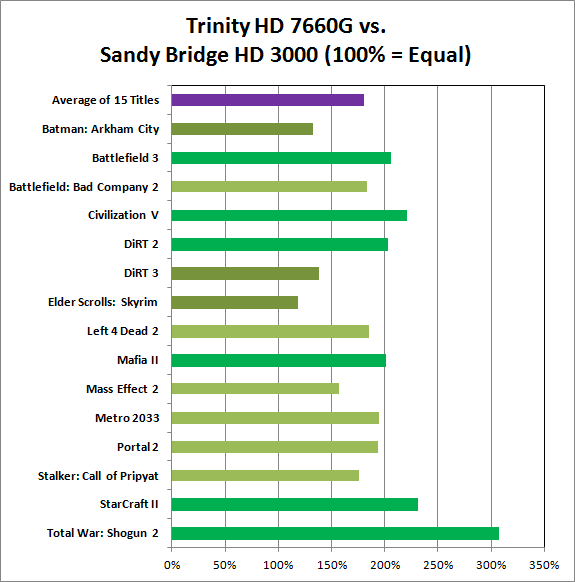
Llano’s HD 6620G was already faster than HD 3000, and Trinity’s HD 7660G is faster than Llano, so the Sandy Bridge gaming matchup is a landslide victory in AMD’s favor. The closest Intel can get is in the same three titles where Ivy Bridge leads Trinity: Batman: Arkham City, DiRT 3, and Skyrim. Here, however, HD 3000 can’t actually close the gap and HD 6620G is at least 20% faster than HD 3000, with an average performance improvement of nearly 80%.
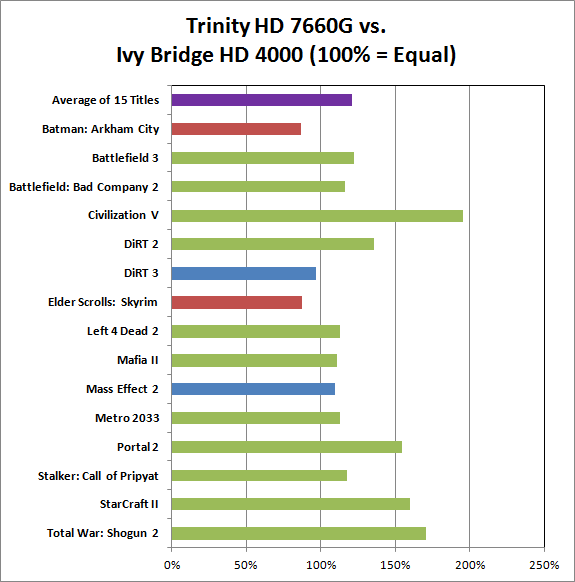
We found that across the same selection of 15 titles, Ivy Bridge and Llano actually ended up “tied”—Intel led in some games, AMD in others, but on average the two IGPs offered similar performance. This chart and the next chart will thus show a similar average increase in performance for Trinity, but the details in specific games are going to be different. Starting with Ivy Bridge and HD 4000, as with our earlier game charts we see there are some titles where Intel leads (Batman and Skyrim), a couple ties (DiRT 3 and Mass Effect 2), and the remainder of the games are faster on Trinity. Mafia II is close to our <10% “tie” range but comes in just above that mark, as do Left 4 Dead 2 and Metro 2033. The biggest gap is Civilization V, where Intel’s various IGPs have never managed good performance; Trinity is nearly twice as fast as Ivy Bridge in that title. Overall, it's a 20% lead for Trinity vs. quad-core Ivy Bridge.
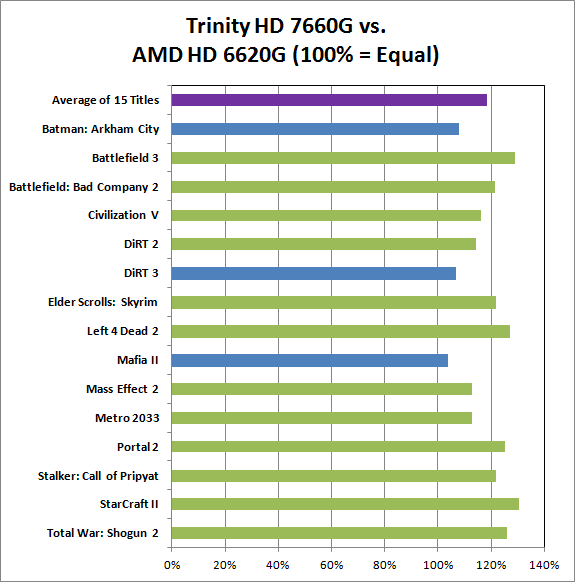
Against Llano, Trinity is universally faster, but the smallest gap is in Mafia II (3%) while the largest gap is in StarCraft II (30%). On average, looking at these games Trinity is only 18% faster than Llano. What’s not entirely clear from the above chart is whether we’re hitting CPU limitations, memory bandwidth limitations (remember that Llano and Trinity share bandwidth with the rest of the system), or perhaps both. At our chosen settings, what is clear is that Trinity’s “up to 56% faster” graphics never make it that high.
We saw 35-45% higher scores in 3DMark 11 and Vantage, which tend to remove the CPU from the equation more than actual games, so our guess would be that if AMD continues with their APU plan they’re going to need to work more on the CPU side of the equation. We also see the same thing looking at the VAIO SE scores in the earlier gaming charts: the HD 6630M scores are 20% faster on average, but much of that appears to come from the faster CPU rather than the GPU.










271 Comments
View All Comments
Stas - Tuesday, May 15, 2012 - link
I agree with xd_1771. A mid-range CPU from 2 years ago is plenty for any CPU requirements an average user might have (Office, browser, IM, pr0n). The one thing that's been limiting laptops for generations is the GPU. AMD has brought serious graphics to laptop. Not only do you benefit through improvements in gaming and 3D software, with almost every resource intensive application becoming GPU-accelerated, you get better performance all-around.zephxiii - Tuesday, May 15, 2012 - link
I am using this old Thinkpad T60 with C2D 1.66ghz built in 4/2007 and it is plenty fast enough for regular use lol. The only thing that really sucks about it is the spinning HD in it.I use a T61p at home with C2D 2.2ghz and Quadro something HD with SSD and that thing does everything I need it to (Photoshop, lightroom, Internet, flash video etc.).
Both running Windows 7.
BSMonitor - Tuesday, May 15, 2012 - link
Nope, I promise that C2D 1.66Ghz lags for Flash enhanced./Java Runtime environments. Especially multitasking.Please, quit defining regular use with acceptance of slow. Drop even Core 2 Quad 9550 in that home PC, and I promise you would not go back.
Belard - Tuesday, May 15, 2012 - link
I have a ThinkPad R61 with PDC (Bottom end Core2 with missing cache) at 1.6Ghz. I bought for $550 off the shelf new when VISTA was about 8 months old. It came with XP-Pro, 1GB RAM and more importantly, a matte screen. I use it almost every day and since then I've added 1GB and Windows7 and it runs better than it ever did when it was new.Its slow compared to more C2Q Q6600, but the R61 does what I need for a mobile system. I sure don't like using Photoshop on it. But its mostly for browsing, Office apps and xfer of data/work.
It still faster than ANY Pentium4 class CPU.
I have an urge to go IvyBridge this year... but my Q6600 doesn't really keep me waiting much (other than video encoding) with 4GB / Win7. Nope, going on vacation this summer out-weighs a new computer. :)
BSMonitor - Tuesday, May 15, 2012 - link
Stop telling everyone what CPU is GOOD enough. There truly is software out there that my Core 2 Duo at work lags behind. My Core i7 system at home is remarkable smoother and more responsive. Neither with an SSD.tfranzese - Tuesday, May 15, 2012 - link
For a user who can't stand to wait, you've got your priorities screwed up if you're not using an SSD on those system.evolucion8 - Tuesday, May 15, 2012 - link
I wonder which kind of sofware tuns too slow on a C2D. I have a i7 2600K at 4.5GHz, much faster on WinRaR, media encoding, gaming etc. But running everyday tasks like web browsing, office, media playback etc, doesn't feel much different from my Core 2 T9300 and my i7 machine. My laptop does have very good encoding power which is very tolerable, but definitively my i7 destroys it, but considering that my C2D has a 35W TDP I don't loosing some performance for the sake of lower heat dissipation and battery consumption.vegemeister - Tuesday, May 15, 2012 - link
We were just getting to the point where a CPU could be good for 6-8 years, but then the web developers started making applications and desktop environments. Not to mention the horrors of flash and Java. What Intel giveth, web 2.0 taketh away.medi01 - Thursday, May 17, 2012 - link
Bullshit.Most of the web 2.0 is nowadays "also gotta run on tablets" and no way inhell it's "java based", or "flash based" or CPU intensive.
seapeople - Tuesday, May 22, 2012 - link
You people are a little crazy coming up with exotic applications that stress CPUs. It's much simpler than that.I'm running a Q2720m with Intel SSD and fiber optic internet, and I notice immediately if I turn turboboost off while browsing standard webpages with Chrome + Adblock. My browsing is noticeably CPU limited, especially in cases where I'm clicking through dozens of large webpages to find a specific page I'm looking at (such as browsing backwards through poorly designed blogs).
I would detest running something with the single-threaded speed of AMD's latest offerings. Of course, that's why I'm not in that target market.